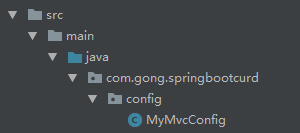这篇文章主要介绍了springboot开发扩展springmvc实现解析,文中通过示例代码介绍的非常详细,对大家的学习或者工作具有一定的参考学习价值,需要的朋友可以参考下
可以在Java定义自己配置的springmvc:

MyMvcConfig.java
package com.gong.springbootcurd.config;
import org.springframework.context.annotation.Bean;
import org.springframework.context.annotation.Configuration;
import org.springframework.web.servlet.config.annotation.EnableWebMvc;
import org.springframework.web.servlet.config.annotation.ViewControllerRegistry;
import org.springframework.web.servlet.config.annotation.WebMvcConfigurer;
//@EnableWebMvc 接管springmvc
@Configuration
public class MyMvcConfig implements WebMvcConfigurer{
@Override
public void addViewControllers(ViewControllerRegistry registry) {
//浏览器发送gong请求会跳转到/templates/success.html页面
registry.addViewController("gong").setViewName("success");
}
//所有的WebMvcConfigurer会一起起作用
//将组件注册到容器中
@Bean
public WebMvcConfigurer webMvcConfigurer() {
WebMvcConfigurer webMvcConfigurer = new WebMvcConfigurer(){
public void addViewControllers(ViewControllerRegistry registry) {
registry.addViewController("/").setViewName("index");
registry.addViewController("/index.html").setViewName("index");
}
};
return webMvcConfigurer;
}
}
关键有三点:
(1)实现WebMvcConfigurer。
(2)用Configuration标识配置类。
(3)如果是public WebMvcConfigurer webMvcConfigurer() {...},则需要用@Bean标识。
以上就是本文的全部内容,希望对大家的学习有所帮助,也希望大家多多支持亿速云。
免责声明:本站发布的内容(图片、视频和文字)以原创、转载和分享为主,文章观点不代表本网站立场,如果涉及侵权请联系站长邮箱:is@yisu.com进行举报,并提供相关证据,一经查实,将立刻删除涉嫌侵权内容。